Sadly most seem more determined to show that the digital computer was developed in their own country by their own company than they are to correctly attribute the pioneering work of individuals. For example, the bizarre legal ruling in an American court in 1971, that the Atanasoff-Berry Computer was not the first digital computer, in favour of ENIAC's claim. A legal ruling reversed in 1973 after a lengthy court trial. So now you can be sued for denying that Iowa State University's slogan Birthplace of the Electronic Digital Computer is true!
On many pages on the web you will find something like this The world's first electronic digital computer was developed by Army Ordnance to compute World War II ballistic firing tables and To help the public remember that it was the U. S. Army which initiated the computer revolution., but that again just isn't true.
The first computer was Colossus operational in January 1944. Unfortunately Colossus was kept secret until 1970, allowing the Americans to get away with their claim that ENIAC was the very first computer.
But Colossus wasn't 'designed and built ' by Alan Turing. That is another wide-spread myth. Its prototype (not Colossus) was conceived by Max Neuman (a British mathematician, frequently confused on the net with the American, but originally Hungarian, computer pioneer John von Neumann).
The initial prototype wasn't called Colossus, but jocularly dubbed 'Heath Robinson'. It was designed by Neuman and C. E. Wynn-Williams and engineered and built by a General Post Office (G.P.O.) team at Dollis Hill GPO Research Station in north-west London, England. Construction started in January 1943 and the machine was up and running in June that year. However, it quickly ran into problems in keeping two punched paper tapes in synchrony at 1,000 characters per second, but it worked well enough to show that Max Neuman's concept was the right one.
Thomas (Tommy) Flowers a G.P.O. Dollis Hill top engineer and brilliant electronics expert, was called in at the suggestion of Alan Turing and it was Flowers who proposed an all electronic machine, i.e., all valves (vacuum tubes) rather than the mixture of valves and relays.
Tommy Flowers' major insight was to propose that the wheel patterns be generated electronically in ring circuits, not mechanically, thus doing away with one paper tape and completely eliminating the synchronisation problem.
His innovative solution seemed good in theory but 'expert' opinion was that the 2,000 valves that Flowers was proposing would not work.
Before the war, Flowers had designed G.P.O. telephone repeaters using valves. He knew that valves were reliable provided that they were never switched on and off but no one else believed him. Fortunately Neuman decided not to press forward with Heath Robinson and gave Flowers a free hand. Colossus was the result, the first true electronic computer, it was entirely the idea of Tommy Flowers. As Jack Copeland, the Director of the Turing Archive for the History of Computing, puts it: ".. Flowers had established decisively and for the first time that large-scale electronic computing machinery was practicable. "
How does Colossus compare with the Atanasoff-Berry prototype computer? The final Atanasoff-Berry computer was the size of a desk, weighed 700 pounds, had over 300 vacuum tubes, and contained a mile of wire. It could calculate about one operation every 15 seconds. By comparison Colossus was blindingly fast even by today’s standards.
In the words of Tony Sale: " Because of its parallel nature it is very fast, even by today's standards. The intercepted message, punched on to ordinary teleprinter paper tape, is read at 5,000 characters per second. The sprocket holes down the middle of the tape are read to form the clock for the whole machine. This avoids any synchronisation problems: whatever the speed of the tape, that's the speed of Colossus. Tommy Flowers once wound up the paper tape drive motor to see what happened. At 9,600 characters per second the tape burst and flew all over the room at 60 mph! It was decided that 5,000 cps was a safe speed.
At 5,000 cps the interval between sprocket holes is 200 microsecs. In this time Colossus will do up to 100 Boolean calculations simultaneously on each of the five tape channels and across a five character matrix. The gate delay time is 1.2 microsecs which is quite remarkable for very ordinary valves. It demonstrates the design skills of Tommy Flowers and Allen Coombs who re-engineered most of the Mark 2 Colossus. Colossus is so fast and parallel that a modern PC programmed to do the same code-breaking task takes as long as Colossus to achieve a result!"
(Main source: 'Colossus and the Dawning of the Computer Age' by B. Jack Copeland in 'Action This Day - Bletchley Park from the breaking of the Enigma Code to the birth of the modern computer', edited by Smith and Erskine, Bantam Press, 2001)

Computer Chronology
1822
Charles Babbage, an English mathematician, built a working model of his Difference Engine which he had conceived in 1812. Construction started in 1823, but was abandoned. He was assisted by Lady Ada Lovelace, also a brilliant mathematician.
1823
Babbage designed a general purpose, fully programmable mechanical digital computer, which he called an Analytical Engine; it was to use punched cards and be steam driven but was never built. We now know that it would have worked and it is now regarded as the first true predecessor of the modern computer.
Ada Lovelace's descriptions of these advanced machines preserved them for posterity and a working model, built in 1991, is now in the British Science Museum. The high-level computing language Ada was so named in honour of Lady Lovelace.
1906
Lee De Forrest, an American, invented and patented the triode valve (or triode vacuum tube). These were used in radio sets and early computers until the invention of the transistor.
1936
Alan Turing formalizes the notion of calculableness and adapts the notion of algorithm to the computation of functions. The Universal Turing Machine is, given time, capable of computing any calculable function.
But I would say that in 1945 Alan Turing alone grasped everything that was to change computing completely after that date: the universality of his design, the emphasis on programming, the importance of non-numerical applications, the apparently open-ended scope for mechanising intelligence. He did not do so as an isolated dreamer but as someone who knew about the practicability of large-scale electronics, with hands-on experience.
The idea of one machine for every kind of task was very foreign to the world of 1945. Even a decade later, in 1956, the big chief of the electromagnetic relay calculator at Harvard, Howard Aiken, could write: If it should turn out that the basic logics of a machine designed for the numerical solution of differential equations coincide with the logics of a machine intended to make bills for a department store, I would regard this as the most amazing coincidence that I have ever encountered.
But that is exactly how it has turned out. It is amazing, although we now have come to take it for granted. But it's not a mere coincidence. It follows from the deep principle that Alan Turing saw in 1936: the Universal Turing Machine.
1939
John Vincent Atanasoff designed a prototype for the ABC (Atanasoff-Berry Computer) with the help of graduate student Clifford Berry at Iowa State College. On October 19, 1973, US Federal Judge Earl R. Larson signed his decision following a lengthy court trial which declared the ENIAC (see 1946) patent of Mauchly and Eckert invalid and named Atanasoff the inventor of the electronic digital computer. As a result of this misguided ruling Iowa State University claims that it is "The Birthplace of the Electronic Digital Computer"!
1943
Colossus is designed and built by Thomas (Tommy) Flowers. Colossus was entirely the idea of Flowers and he built it in record time.
1946
The ENIAC (Electronic Numerical Integrator And Calculator) had thirty separate units, plus power supply and forced-air cooling. But it was decimal not binary (its major weakness), with 20 accumulators of 10 digits. It had 18,000 vacuum tubes, 1,500 relays, and hundreds of thousands of resistors, capacitors, and inductors. This was a huge machine, weighing 30 tons and occupying 15,000 square feet. ENIAC could carry out 5,000 additions per second.
1947
On 23 December John Bardeen and Walter Brattain successfully demonstrate a solid state germanium based amplifier at Bell Labs. Several days later, following a suggestion made by J. R. Pierce, Brattain calls it a 'transistor'. However, although an extremely important breakthrough, this original germanium based point-contact transistor proved to be extremely difficult and impractical to manufacture.
1948
Following the crucial breakthrough of Bardeen and Brattain, in January William Shockley invented the junction transistor, destined to surpass the point-contact transistor of Bardeen and Brattain in importance. In 1956 all three were awarded the Nobel prize for the transistor.
On 30 June, Bell held a press conference and announced the transistor. The press made but a brief mention of 'a device called a transistor', mostly confining it to the back pages.
1949
Maurice Wilkes assembles the EDSAC, the first practical stored-program computer, at the University of Cambridge, England. The EDSAC (Electronic Delay Storage Automatic Computer) performed its first calculations on 6 May 1949, a table of squares from 0 to 99 in 2 minutes and 35 seconds.
1950
ERA (Engineering Research Associates) 1101, one of the very first commercially produced computers.
1951
The first game 'played by computer'. Alan Turing wrote two programs, but didn't complete them sufficiently to be able to run them on the University of Manchester's Ferranti Mark I computer. However, at least two games have been preserved which were played through by laborious hand simulation.
1952
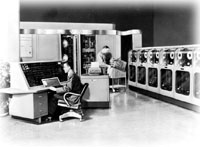 The UNIVAC is delivered to the US Census Bureau attracting widespread public attention.
The UNIVAC is delivered to the US Census Bureau attracting widespread public attention.
1953
IBM enters the commercial field with the 701 computer. 
1954
A milestone year for the future of computers. Gordon Teal, at Texas Instruments Inc, perfected a silicon-based junction transistor both cheaper and more stable than the germanium based point-contact transistor. This was the first practical commercial transistor, and it was this transistor which launched the solid-state revolution.
1955
 TRADIC, the first fully transistorised computer, was announced by Bell Laboratories.
TRADIC, the first fully transistorised computer, was announced by Bell Laboratories.
1956
Things gather pace now. MIT researches build the TX-0, the first general purpose programmable fully transistorised computer, and IBM introduces magnetic disk storage.
1958
Jack Kilby, at Texas Instruments Inc., creates the first integrated circuit with resistors and capacitors on the same piece of semiconductor material.
The first program to play proper chess was developed at the Massachusetts Institute of Technology (MIT) by Alex Bernstein and others. It ran on an IBM 704, which could perform some 1 billion calculations per day, it took about 8 minutes to produce a move.
1959
IBM's 7000 mainframe series are their first computers to be fully transistorised.
Robert Noyce, at Fairchild Camera and Instrument Corp, invents a practical integrated circuit which can be directly printed onto a silicon surface.
1960
Bell Lab launches the Dataphone, the first commercial modem.
Digital Equipment Corporation (DEC) launch the precursor to the minicomputer, the PDP-1.
High level programming language Algol (Algorithmic language) introduced. Prior to this computers were programmed in machine code and in assembly language.
1964
Seymour Cray designs the 6600 supercomputer which could perform 3,000,000 instructions per second. It cost a mere $7,000,000.
John Kemeny and Thomas Kurtz develop the BASIC (Beginners All-purpose Symbolic Instruction Code) programming language at Dartmouth College. BASIC later became the most widespread programming language for microcomputers, often stored in ROM.
1965
DEC launches the PDP-8, the first minicomputer.
1968
Robert Noyce (see 1959) and Gordon Moore (he of Moore's Law), two engineers working for the Fairchild Semiconductor Company, decided to leave and create their own company, backed by venture capitalist Art Rock. Rock raised 2.5 million dollars. On 18 July they founded Intel, coining the name from Integrated electronics.
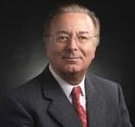 While working at Fairchild in 1968, Federico Faggin, an Italian computer scientist born in 1941 in Vicenza, developed silicon-gate technology, a new process technology for fabricating high-density, high-performance MOS (Metal Oxide Semiconductor) ICs (Integrated Circuits). Intel adopted this technology, allowing it to build high-performance memories and the microprocessor before the competition did. Faggin later recalled that "My desire to design complex ICs with silicon-gate technology led me to work for Intel." Faggin's own account of the birth of the microprocessor can be accessed here
While working at Fairchild in 1968, Federico Faggin, an Italian computer scientist born in 1941 in Vicenza, developed silicon-gate technology, a new process technology for fabricating high-density, high-performance MOS (Metal Oxide Semiconductor) ICs (Integrated Circuits). Intel adopted this technology, allowing it to build high-performance memories and the microprocessor before the competition did. Faggin later recalled that "My desire to design complex ICs with silicon-gate technology led me to work for Intel." Faggin's own account of the birth of the microprocessor can be accessed here
1971
The first advertisement for a microcomputer (the word microprocessor was coined much later), the Intel 4004, designed by Federico Faggin in association with Stanley Mazor and Marcian Edward Hoff, appears in Electronic News.
Computing as we know it really started with this small integrated chip which has since been hailed as one of the most important inventions of the 20th century. Hitherto, 'computers' were huge specialised machines costing thousands if not millions of dollars and occupying several large enclosed consoles and often requiring a team of human operators. Moreover, the 4 bit 4004 had the computing power of the ENIAC. The 4004 packed 2,300 transistors with 10 micron spacing. It ran at 108KHz, executed 60,000 operations a second, but could only address 640 bytes of RAM.
Gary Kildall, a computer-science lecturer, wrote an operating system for the 4004, this turned it into a general purpose processor and, to Intel's surprise, sails rocketed. This OS became known as CP/M (Control Program for Microprocessors). Kildall formed Digital Reaserch to exploit CP/M. Gary Kildall also invented BIOS (Basic Input Output System), the core ROM logic in every PC which loads the OS and links it to the hardware.
Invention of the 8 inch floppy disk by a team of engineers led by Alan Shugart at IBM's San Jose Laboratories. First called a memory disk, the name floppy came from its flexibility.
The Kenbak-1 personal computer is advertised in Scientific American. The Kenbak-1 had 256 bytes of memory and cost $750. Few wanted it, though, and only 40 models were sold
1972
The Intel 200KHz 8 bit 8008 microprocessor is introduced. For a detailed account of the evolution of the 4004 to the 8008 and beyond see The History of the Microcomputer by Stanley Mazor, an eminent computer engineer, who worked on the specifications of the early Intel microprocessors.
1973
The Micral is the earliest commercial personal computer. It was conceived in France by François Gernelle and commercialised by a company called R2E. It was based on the Intel 8008 chip. The term "microcomputer" first appeared in print in reference to the Micral-N.
Researchers at the Xerox Palo Alto Research Centre (PARC) design the Alto for internal use, the first workstation with a built-in mouse and graphical interface.
1974
Intel release the 2MHz 8 bit 6,000 transistor, 8080 chip. It can address 64Kb of RAM.
 With hindsight, from this point, desktop machines quickly became seriously useful, thanks to CP/M and the introduction of BASIC interpreters, but at the time this wasn't recognised. Intel Chairman Emeritus Gordon Moore remembers, "In the mid-1970s, someone came to me with an idea for what was basically the PC. The idea was that we could outfit an 8080 processor with a keyboard and a monitor and sell it in the home market. I asked, ‘What’s it good for?’ And the only answer was that a housewife could keep her recipes on it. I personally didn’t see anything useful in it, so we never gave it another thought."
With hindsight, from this point, desktop machines quickly became seriously useful, thanks to CP/M and the introduction of BASIC interpreters, but at the time this wasn't recognised. Intel Chairman Emeritus Gordon Moore remembers, "In the mid-1970s, someone came to me with an idea for what was basically the PC. The idea was that we could outfit an 8080 processor with a keyboard and a monitor and sell it in the home market. I asked, ‘What’s it good for?’ And the only answer was that a housewife could keep her recipes on it. I personally didn’t see anything useful in it, so we never gave it another thought."
Federico Faggin (see 1968) co-founded Zilog inc. At Zilog he conceived the architecture for the Z80 family of microprocessors. (see 1976).
Bill Gates and Paul Allen sign a licensing agreement with MITS for their version of the BASIC programming language for the MITS Altair 8800. Gates and Allen receive US$3,000 immediately, with royalties of $30 per copy of 4K BASIC, and $35 for 8K BASIC. In December 1974 the Altair goes in sale, advertised in the January issue of Popular Mechanics.
1975
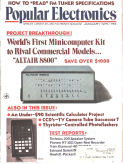 The MITS Altair 8800 was a microcomputer based on Intel's 8080 CPU and was sold as a kit through Popular Electronics magazine. MITS envisaged selling only a few hundred Altairs to hobbyists, however, to their surprise over ten times that many were sold in the first month. Today the Altair is widely seen as the initial spark that led to the personal computer revolution of the next few years.
The MITS Altair 8800 was a microcomputer based on Intel's 8080 CPU and was sold as a kit through Popular Electronics magazine. MITS envisaged selling only a few hundred Altairs to hobbyists, however, to their surprise over ten times that many were sold in the first month. Today the Altair is widely seen as the initial spark that led to the personal computer revolution of the next few years.
1976
The Zilog Z80 microchip, designed by Federico Faggin, was released in July 1976 with a 2.5 MHz clock rate. The Z80 was a much improved version of the Intel 8080 architecture.
Steve Wolzniak designs the Apple 1.
The 5¼ inch disk drive and floppy disk are introduced by Shugart Associates.
1977
 Apple Computers introduced the Apple II. It came without a monitor or tape cassette input, had 4K RAM and a MOS Technology 6502 cpu running at 1MHz. What was amazing at the price was that it had colour graphics (16 colours at a resolution of 280×160 pixels), although you had to have a colour TV to see them. This was the first computer I ever saw, in a shop in Tottenham Court Road, London. It cost $1,298 in the USA, and around £2,000 in the UK (about £7,500 in today’s values!).
Apple Computers introduced the Apple II. It came without a monitor or tape cassette input, had 4K RAM and a MOS Technology 6502 cpu running at 1MHz. What was amazing at the price was that it had colour graphics (16 colours at a resolution of 280×160 pixels), although you had to have a colour TV to see them. This was the first computer I ever saw, in a shop in Tottenham Court Road, London. It cost $1,298 in the USA, and around £2,000 in the UK (about £7,500 in today’s values!).
The first ever chess game won by a computer program, CHESS 4.7, against a grandmaster. It beat Michael Stean, Britain's number 2.

Commodore introduced the PET (Personal Electronic Transactor). This was another great step forward for affordable personal computing. Click on the photo to see an advert for the PET.
1978
Intel release the 16 bit 8086 chip, with three clock speeds up to 10MHz. It could address up to 1Mb of RAM. It was later to become the classic chip of IBM-PC clones. For a very full technical and more extended description of this chip and all subsequent microprocessors I recommend A CPU History by David Risley.
1979
Motorola introduces the 68000 microprocessor. With a 32 bit internal structure, making it more powerful than the two dominant 16 bit microprocessors, the Intel 8086 and the Zilog Z8000, and running at 8MHz, Personal Computer World commented "The speed of the M68000 is also something to be marvelled at."
The first advertisements for Visicalc appear in the May issue of Byte, it was to become an essential software tool for nearly all trades and professions, greatly increasing the perceived usefulness of the microcomputer in business. Visicalc, the forerunner of all electronic spreadsheets, was created by Dan Bricklin and Bob Frankston. The first version was produced for the Apple II, it was 25Kb long and cost $100.
Word processing began to appear. In January a primitive word processor was developed by ICL Dataskill. Then Micropro released Wordstar and Apple launched Applewrite I for the Apple II. Wordstar was dominant until the release of Word at the end of 1983.
Japan entered the market with Sharp's launch of the MZ-80K, based on the Z80 chip.
1980
Seagate Technologies launch the ST-506, the first hard disk drive for microcomputers. Capacity 5Mb.
Acorn Atom micro introduced in UK by Acorn Computers Ltd of Cambridge. It could be had as a kit with 2K RAM for £140 (£360 in today's values) or already assembled with 12K Ram for £289.50 (about £740 today), no monitor, of course, and the power supply (1.5v) was £10.20 extra. Nonetheless, this was an outstanding personal computer kit.
 Clive Sinclair achieved what everyone thought was impossible: a computer for under £100! His ZX80, based on the Z80 chip running at 3.25MHz with 1Kb of RAM expandable to 16Kb, could be bought in kit form for £79.95 or already assembled for £99.95. Computing for the masses had arrived.
Clive Sinclair achieved what everyone thought was impossible: a computer for under £100! His ZX80, based on the Z80 chip running at 3.25MHz with 1Kb of RAM expandable to 16Kb, could be bought in kit form for £79.95 or already assembled for £99.95. Computing for the masses had arrived.
Tim Berners-Lee devises a program called "Enquire" for his own private use, his first program for storing information linked by random associations. This brilliant program, never published, formed the conceptual basis of the World Wide Web.
1981
IBM introduces the PC (Personal Computer). Until this point IBM had ignored microcomputers, marketing main frame computers. International Business Machines had made their reputation selling typewriters in the 1930s and later business adding machines, thus they were well known and trusted by the American Business community. They had little expertise in microcomputers and required a Disk Operating System. This was provided by Bill Gates, the start of a very lucrative partnership. IBM were taken completely by surpise at the success of the PC, they sold more in one month than they had expected to sell in 5 years. Programmers rushed to write for it and within months the PC had more programs than any other machine.
The original PC's cpu was an Intel 8088 chip running at 4.77MHz. A typical PC configuration with 64Kb RAM, twin 5¼" floppy drives, RS232 (serial port), with a mono 11½" green-phosphor monitor and dotmatrix printer cost $4,575. A minimum configuration, 16Kb RAM with keyboard, single floppy drive, and monitor would be $2,400.
Famously, at a time when 64Kb of RAM was considered huge for a desktop microcomputer, the PC's designers did not believe that any PC user would ever need more than 640KB of RAM, which was the maximum MS-DOS, the chosen OS, could handle. This flawed decision was to result in many years of patch-ups to circumvent the 640Kb limit.
Sony introduces the first 3½ inch floppy drives and disks.
1982
Intel ramps up the pace with the launch of the 12.5MHz, 134,000 transistor, 80286 chip. It can address 16Mb of RAM.
1983
Compaq Computers Corp. launches the first PC clone, using Bill Gates' DOS, the same software as the IBM PC.
Microsoft released MS-DOS 2.0, designed to support the IBM-PC-XT, and released Word 1.0, but failed to interest IBM in a proto-type Windows. Probably with good reason, since an effective GUI (Grapic User Interface) required more computing power than was then available.
1984
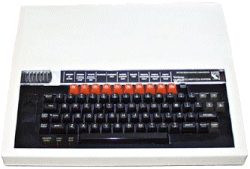 Apple Computers launches the Macintosh, the first successful mouse-driven computer with a GUI (Graphic User Interface).
Apple Computers launches the Macintosh, the first successful mouse-driven computer with a GUI (Graphic User Interface).
IBM launches the PC-AT (Personal Computer - Advanced Technology) based on the Intel 286 cpu and three times faster than the original PC. The AT introduced the 16-bit ISA bus and on which are based all modern computers.
1985
Intel launches the 32 bit 33MHz 80386 chip.
1986
DOS based PC clones begin their unstoppable ascent. Compaq led with its Deskpro 386, based on Intel's true 32 bit processor, the Intel 80386. It set the standard for PCs for years to come.
1987
IBM introduces the PS/2 PCs, which make the 3½ inch floppy disk drive and VGA video standard for PCs.
Acorn release the Archimedes, possibly the world's fastest micro then available. The power came from Acorn's ARM (Advanced Risc (Reduced Instruction Set Computer) Machines technology which achieved 4 mips (million instructions per second) from a 4MHz clock speed. No fans were required and the computer ran totally silent.
Micosoft releases Word 2.0 for DOS.
1989
 Tim Berners-Lee, with the help of Robert Cailliau, conceived and proposed a global hypertext project to be know as the World Wide Web, based on his earlier 'Enquire' program (see 1980 entry). It was designed to allow knowledge to be pooled and freely shared in a web of hypertext documents. He wrote the first World Wide Web server. "http" and the first client "WorldWideWeb".
Tim Berners-Lee, with the help of Robert Cailliau, conceived and proposed a global hypertext project to be know as the World Wide Web, based on his earlier 'Enquire' program (see 1980 entry). It was designed to allow knowledge to be pooled and freely shared in a web of hypertext documents. He wrote the first World Wide Web server. "http" and the first client "WorldWideWeb".
Intel releases the 50MHz 80486 chip, containing over one million transistors. Intel also introduces motherboard chipsets.
1990
The World Wide Web is initiated on Christmas Eve, the brainchild of Tim Berners-Lee. Initially for CERN and a few friends, but has difficulty convincing his CERN colleagues of its use.
1991
Tim Berners-Lee makes the World Wide Web available free of charge to the Internet. He continues to work on it, improving it with feedback from users, until 1993. His initial specifications of URLs, HTTP and HTML were refined as the Web technology spread.
Computer History: 1990 to the present
For a detailed history of computing since 1990 click here. It is pointless duplicating this detailed information on the Wikipedia.The following timeline relates only to my personal experience of computing:
I started reading computer magazines and learning everything I could about microcomputers. I buy Personal Computer World, Volume 1, Issue No. 1, May 1978.
1982
28 May, I get my first microcomputer, a Model B BBC (Acorn), serial No. 007548, having ordered it in 1981. It had 1Mb of RAM and a very advanced Operating System with excellent inbuilt BASIC. I started to code in my first programs in BASIC, spending hours debugging. I sold this model in 1984.
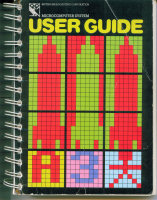 Whilst researching this history I found a site which referred to the infamous BBC Micro. This is quite wrong; we should not view the past through the prism of the present. The BBC Micro was a much better machine than the IBM PC. Launched with a BBC TV programme, it made the UK one of the most computer-literate countries in the world. The PC came to dominate not because it was a better computer than the rest (it wasn't) but because the prestige of IBM ensured confidence and sales in America, which in turn attracted software houses to concentrate on it.
Whilst researching this history I found a site which referred to the infamous BBC Micro. This is quite wrong; we should not view the past through the prism of the present. The BBC Micro was a much better machine than the IBM PC. Launched with a BBC TV programme, it made the UK one of the most computer-literate countries in the world. The PC came to dominate not because it was a better computer than the rest (it wasn't) but because the prestige of IBM ensured confidence and sales in America, which in turn attracted software houses to concentrate on it.
1984
30 May, I upgraded my computer: a much improved Model B BBC computer, serial No. 3784286, Issue 7 board, with Acorn OS 1.20 and BBC Basic II. I still have its 516 page 'User Guide' manual.
1988
10 May, I bought an Acorn Archimedes Model 310, an advanced 32 bit reduced instruction set (RISC) machine at a time when PCs were still stuck with DOS and 16-bit architecture. Very little software was available for it, programmers being attracted to the lucrative PC market.
1997
I decided to switch to PCs. Bought a top specification model, a Pentium II 300 MHz with 64Mb of EDO RAM, and a 5Gb hard disk from Elonex, initially running NT 4.00.
1998
3 January I went online.
2000
Opened my website.
2001
Upgraded to an Evesham model Evolution 2000G3 computer with a 2GHz Pentium 4, 512 Mb RDRAM and a 100Gb Western Digital hard drive, with Windows Xp (the first genuine 32 bit OS from Microsoft). It had 3 firewire ports, 4 USB ports, a CD player/recorder and a DVD/CD player, plus a 250Mb internal Zip drive. An unimaginable configuration when I first saw a microcomputer in 1977, and at a fraction of the price. An enourmous advance in just 25 years.
2003
My 100Gb hard drive failed, an Evesham engineer came to the house to replace it free of charge under guarantee. The 100Gb was no longer in production, so it was replaced with a 'state of the art' Western Digital WD1200 Caviar Special Edition 120Gb drive with a massive 8Mb data buffer. I now have a cutting-edge technology computer! Well, for a few weeks, anyhow.
2004
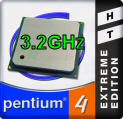 On 15 September I upgraded my PC with a Pentium P4 - 3.2E GHz 'Prescott processor, 1 Mb 2nd cache, with an Asus mPGA 478 P4800-E Deluxe motherboard with a single module Kingston 512 DDR 400 RAM, now powered with a 550 Watt large fan power supply unit, all in my original case. Two internal 120Gbyte HDs and an external 80 Gbyte HD for back up. All this at the fraction of the cost of a new PC, simply by slotting in new modules. In the recent past for hi-fi sound you needed to by-pass the motherboard sound and install a separate sound card. But the sound from the Asus motherboard could not be bettered by any current card. I have never heard my music so clear and vibrant. Now, if only we could get a silent PC!
On 15 September I upgraded my PC with a Pentium P4 - 3.2E GHz 'Prescott processor, 1 Mb 2nd cache, with an Asus mPGA 478 P4800-E Deluxe motherboard with a single module Kingston 512 DDR 400 RAM, now powered with a 550 Watt large fan power supply unit, all in my original case. Two internal 120Gbyte HDs and an external 80 Gbyte HD for back up. All this at the fraction of the cost of a new PC, simply by slotting in new modules. In the recent past for hi-fi sound you needed to by-pass the motherboard sound and install a separate sound card. But the sound from the Asus motherboard could not be bettered by any current card. I have never heard my music so clear and vibrant. Now, if only we could get a silent PC!
2008
29 July, having sold my desktop Evesham PC, I bought a laptop. An Acer Aspire 8920g.
Specification:
- cpu: Intel Centrino Duo T9300 45nm 2.5 GHz, 6Mb L2 cache
- 800 MHz FSB
- 4Gb RAM
- Two 320 Gb HDs
- 4 USB 2.0 ports
- Bluetooth enabled
2009
16 January, bought an Apple 24" iMac.
Specification:
- cpu: Intel Core 2 Duo 2.8GHz
- 1.07 GHz FSB
- 2 Gb DDR2 SDRAM 800 MHz
- 320 Gb HD
- Bluetooth
- OS: Mac OS X 10.5.6 'Leopard'
11 September, upgraded 'Snow Leopard' to v. 10.6.1
9 November, upgraded 'Snow Leopard' OS to v. 10.6.2
2010
31 March, upgraded 'Snow Leopard' to v. 10.6.3. This was a 540 Mb upgrade.
16 June, upgraded 'Snow Leopard' to v. 10.6.4
10 November, upgraded 'Snow Leopard' to v. 10.6.5
2011
6 January, upgraded 'Snow Leopard' to v. 10.6.6
2013
January, bought an iPad 4. This had a Apple A6x Dual core 1.4 GHz chip and 9.7 inch screen.
April, bought an Apple iPhone 5. Apple A6 1.3 GHz processor. 4 inch display.
2014
23 October, bought an iPhone 6 Plus. Far more powerful than my early desk top computers. Apple A8 chip, a 2 billion transistors 20nm monster, running at 1.4 GHz; 5.5 inch screen, 64 bit,128 Gb.
2015
30 November, bought an iPad Pro. 12.9 inch screen; Apple A9X 2.2 GHz 2 core 64 bit chip.
2016
25 August, bought an Asus top spec model N752Vx-GC249T laptop. Intel Core i7-6700HQ 2.6 GHz (to 3.5 GHz with turbo boost) 14 nm chip. 17.3 inch screen; 12 Gb RAM; 2 TB HD + 128 Gb SSD. Graphics NVIDIA GeForce GTX950M (N16P-GX) 2 Gb. Windows 10 64 bit. Boots up in under 10 seconds! ... and, finally, runs silently; the fan, when it kicks in, is a faint whisper.
Peter Ghiringhelli
Updated September 2016.
Return to
Top
If you did not arrive at this page from my Home Page you may access it here.